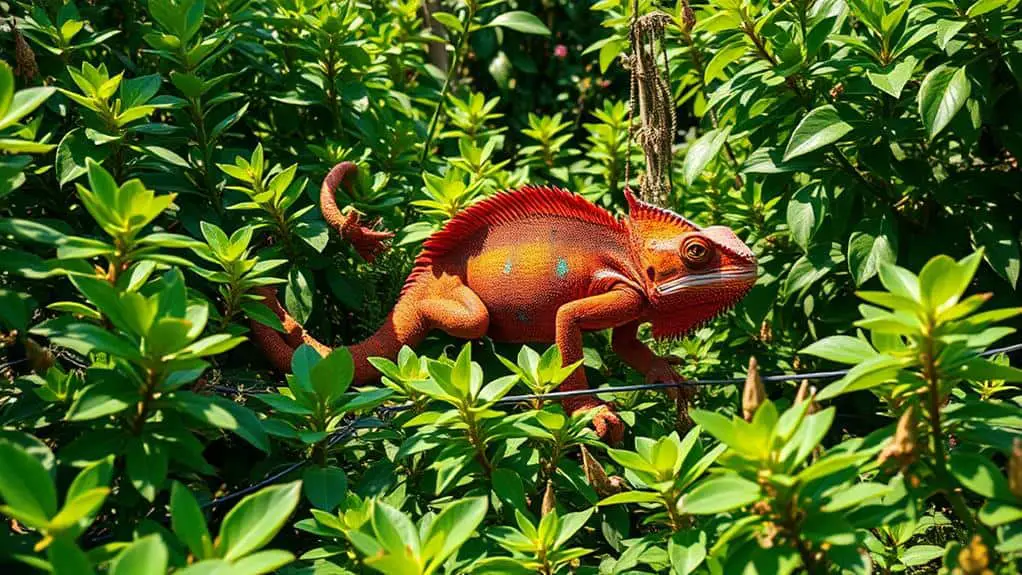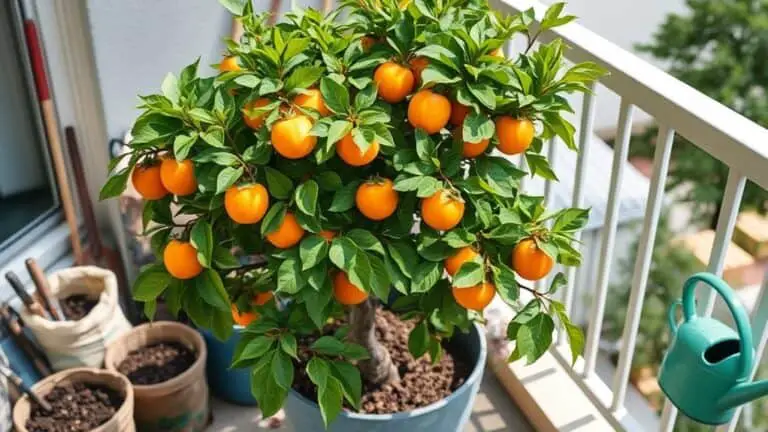How To Get Rid Of Fast Growing Chameleon
Dealing with a fast-growing chameleon plant in your garden can be quite a challenge, but it's not impossible. You'll want to start by identifying the plant accurately and understanding its invasive nature. Manual removal might be your first instinct, but it's essential to get the roots to prevent regrowth. Larger infestations demand more strategic approaches like boiling water or mulching. Have you considered using herbicides carefully? There's much more to explore about long-term management and preventing reinfestation, ensuring your garden stays chameleon-free.
Identify Chameleon Plant

Identifying the chameleon plant, also known as Houttuynia cordata, is essential for managing this invasive species in your garden.
To identify the chameleon plant, look for its heart-shaped leaves, which can show a mix of green, purple, and red colors. This distinctive appearance sets it apart from other ground cover plants.
The plant usually grows to a height of 12-18 inches and spreads through seeds and underground rhizomes. It thrives in moist environments and can be mistaken for other plants, so careful observation is key.
Regularly check your garden to spot any new growth early. By recognizing this plant, you can take steps to control it before it disrupts your garden's ecosystem.
Understand Invasiveness
Understanding the invasiveness of chameleon plants is key to managing their impact on your garden. These plants are native to Southeast Asia but have become invasive in many parts of the eastern U.S., disrupting local ecosystems.
Their vibrant heart-shaped leaves and white flowers may look appealing, but they can outcompete native plants for resources, decreasing biodiversity. Chameleon plants thrive in moist environments, making gardens with standing water particularly vulnerable.
They spread through underground rhizomes, which can break off and resprout, complicating removal. Early intervention is essential because unchecked growth leads to dense mats that choke out other plants and alter the ecosystem balance.
Knowing this helps you take the right steps to protect your garden.
Manual Removal Techniques
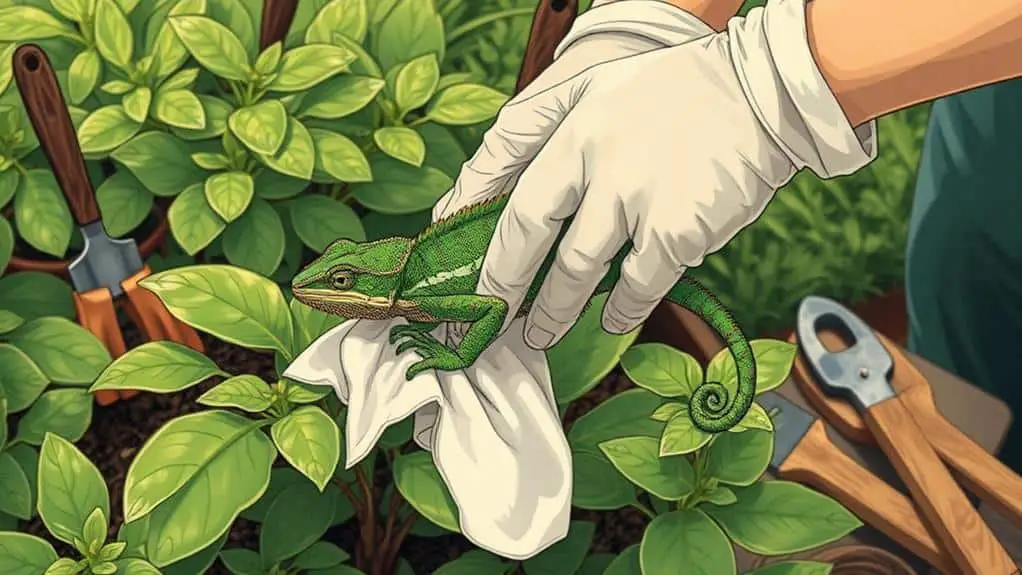
Getting rid of chameleon plants manually is a hands-on but rewarding approach to reclaiming your garden. Start by targeting these invasive plants in spring or fall. Use a shovel to dig a trench at least 12 inches deep around larger patches. This helps with root extraction and prevents regrowth. For smaller infestations, hand-pulling works best. Make sure to grasp the base and pull out the entire root system. Immediately bag and dispose of the plants to stop any spread. Regular monitoring is key to catching new sprouts early.
| Task | Details |
|---|---|
| Best Seasons | Spring or Fall |
| Digging Depth | At least 12 inches |
| Hand-Pulling | Grasp base to extract entire root system |
| Disposal | Bag and remove plants immediately |
With patience and persistence, you'll see progress!
Using Herbicides
When manual removal techniques aren't enough, turning to herbicides can offer an effective solution for controlling fast-growing chameleon plants. Glyphosate is the most effective herbicide for this task.
You'll need to apply it carefully to avoid harming nearby vegetation. Use a high concentration of glyphosate and target the stems to guarantee it reaches the roots.
Always wear protective gear, including gloves and eye protection, to assure your safety. Follow the manufacturer's instructions for application rates and safety precautions.
Sometimes, reapplication after one or two growing seasons is necessary because chameleon plants can regrow if any root fragments remain.
With careful application and patience, you can effectively control and reduce these persistent plants.
Boiling Water Method

Pouring boiling water directly onto chameleon plants can quickly tackle small infestations by killing both foliage and roots on contact.
This method is environmentally friendly and doesn't introduce chemicals into the soil, making it safe for surrounding plants if you're careful. For the best results, apply boiling water during the plant's active growing season when the foliage is lush.
Here's how you can do it:
- Boil water: Use a large pot to guarantee you have enough to cover the area.
- Pour slowly: Target the chameleon plants, ensuring the water reaches the roots.
- Repeat if needed: Larger patches might need multiple treatments.
- Monitor: Keep an eye on the area for any regrowth and treat again if necessary.
This method can help you control chameleon plants effectively!
Mulching for Control
Mulching is a great way to control fast-growing chameleon plants by blocking sunlight, which they need to grow.
Use organic mulches like wood chips or straw, applying a layer at least 2-3 inches thick around your desired plants.
This will create a barrier that helps prevent chameleon plants from taking over, and don't forget to replenish the mulch regularly to keep it effective.
Types of Mulch
One effective strategy for controlling the rapid growth of chameleon plants is using various types of mulch.
Mulch helps block sunlight and creates a barrier, preventing these pesky plants from taking over your garden.
Here are four types of mulch you can use:
- Wood Chips: These organic mulches decompose slowly, improving the soil over time.
- Straw: A light option that suppresses weeds while retaining moisture.
- Landscape Fabric: Use this under mulch to provide an extra layer of protection.
- Compost: Adds nutrients to the soil while keeping unwanted plants at bay.
Application Techniques
To effectively control the spread of chameleon plants, start by applying a thick layer of mulch to your garden.
Use organic mulch like wood chips or straw, spread it at least 3-4 inches deep to block sunlight, which these plants need to grow.
After removing visible chameleon plants, place the mulch to stop any leftover rhizomes from resurfacing.
For extra effectiveness, put landscape fabric under the mulch to prevent root penetration and reduce regrowth chances.
Regularly check the mulched area for any new sprouts and remove them promptly.
This application technique helps maintain control, so your garden stays free of fast-growing chameleon plants.
Stay vigilant and consistent for the best results.
Benefits of Mulching
After applying the mulch to control the spread of chameleon plants, you'll find numerous benefits that go beyond just immediate suppression.
Mulch blocks sunlight, stopping these plants from photosynthesizing and spreading. This layer, about 2-4 inches thick, also retains soil moisture, helping desirable plants thrive.
Organic mulch like wood chips or straw decomposes over time, enriching the soil and deterring chameleon regrowth.
Here are the benefits:
- Prevents new shoots: Stops chameleon plants from emerging.
- Maintains soil moisture: Benefits other plants by keeping the soil damp.
- Enriches the soil: Organic mulch breaks down, improving soil health.
- Reduces maintenance: Combining mulch with manual removal lessens upkeep.
Regularly replenish your mulch to maintain its effectiveness.
Organic Alternatives
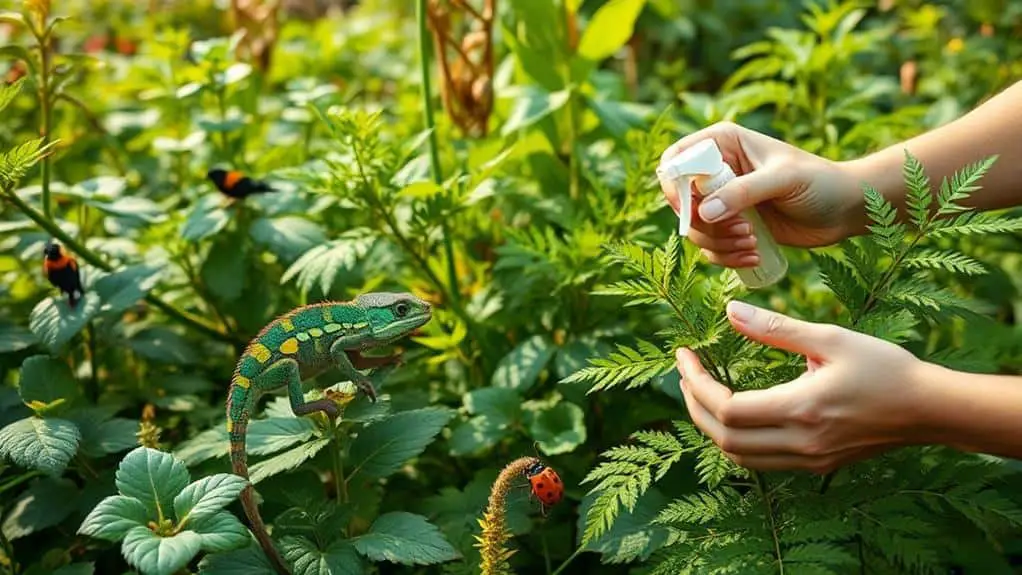
When you're looking for organic alternatives to control fast-growing chameleon plants, there are a few effective methods to contemplate.
Regular hand-pulling small infestations, especially before the rainy season, can keep their numbers in check.
Additionally, mulching and planting competitive native species can block sunlight and outcompete the chameleon plants, helping you maintain a healthy and diverse garden.
Manual Removal Techniques
Tackling the fast-growing chameleon plant can be a challenging task, but manual removal offers an effective organic alternative. To get started, follow these steps:
- Hand-pulling or digging up: Carefully remove the roots, ensuring you get at least 12 inches of rhizome to prevent regrowth.
- Focus on dry weather: Removing plants during dry weather is more effective, as wet soils can make the roots easier to pull but also promote rapid regrowth.
- Dig trenches: For larger infestations, dig a 1-foot-deep trench around the patch to capture and remove extensive root systems.
- Monitor closely: After removal, regularly check the area for new sprouts since even small fragments of rhizomes can resprout.
Mulching and Competitive Planting
Mulching and competitive planting offer effective organic alternatives to managing the invasive chameleon plant. By applying a thick layer of mulch, like wood chips or straw, you block sunlight, making it hard for chameleon plants to regrow. Aim for at least 3 inches of mulch to guarantee effectiveness.
Planting competitive native species, like wildflowers or grasses, can also help. These plants compete for resources, limiting the chameleon plant's growth. Ground covers such as creeping thyme or clover create a dense plant community, further inhibiting invasive species.
| Strategy | Benefit |
|---|---|
| Mulching | Blocks sunlight, retains soil moisture |
| Competitive Planting | Native species outcompete invasive plants |
| Ground Covers | Dense cover inhibits chameleon plant establishment |
Regularly check mulched areas to remove any emerging chameleon plants.
Long-term Management
For long-term management of fast-growing chameleon plants, regular monitoring is essential to catch new growth early.
You'll need a solid removal routine to handle any sprouts you find. Here's a quick guide to help you out:
- Consistent Removal: Make it a habit to check and remove chameleon plants regularly. Pull them up carefully, ensuring no root fragments are left behind.
- Community Education: Talk to your neighbors about the invasive nature of chameleon plants. The more people who know, the better the control.
- Physical Barriers: Use mulch or barriers to block the spread. This helps protect your garden and prevent new growth.
- Integrated Management: Combine manual removal, monitoring, and community efforts for the most effective control.
Stay diligent and proactive!
Preventing Reinfestation
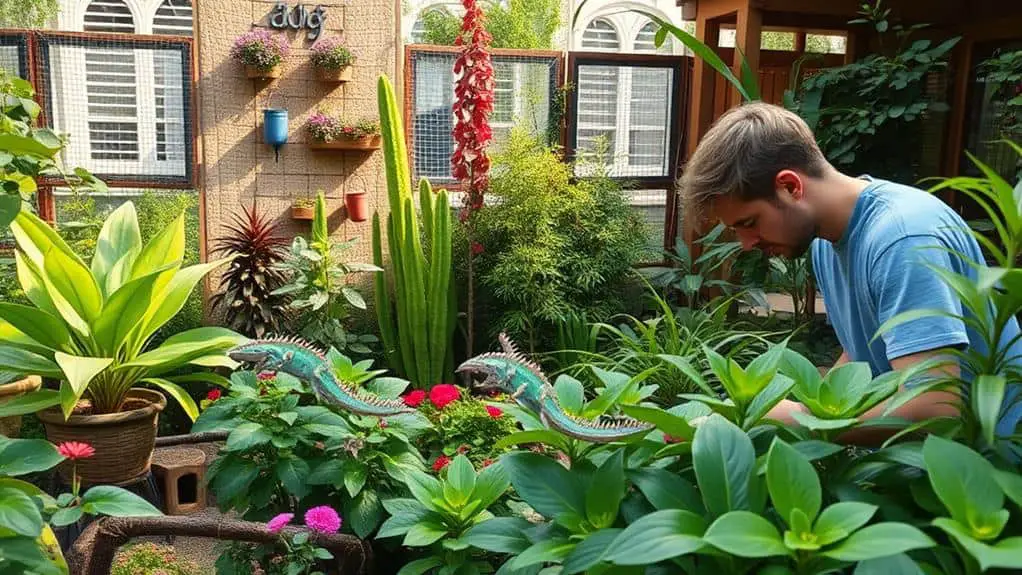
Preventing reinfestation of fast-growing chameleon plants requires vigilant and consistent effort. Regularly inspect your garden areas for any new growth, as catching it early is essential.
Establish a routine maintenance schedule, and hand-pull any emerging plants before they develop deep roots. This keeps them from spreading. Use mulch around your desired plants to block sunlight and suppress the chameleon plant's regrowth.
Plant competitive native species that can outcompete the chameleon plant for resources, making it harder for it to survive. These steps will help in preventing reinfestation.
Community Efforts
To tackle chameleon plant infestations, you can start by organizing neighborhood clean-up days focused on removing these pesky plants and keeping an eye out for new growth.
Educating your neighbors on how to spot and understand the impact of chameleon plants will help everyone work together to stop their spread.
Local Awareness Campaigns
Increasing local awareness about the invasive nature of chameleon plants (Houttuynia cordata) is essential for effective community action.
Local awareness campaigns play an important role in educating neighbors about identifying and understanding the impact of these invasive species. You can make a big difference by participating in community workshops that offer hands-on training for removing these plants.
To help your community:
- Collaborate with local environmental organizations to distribute informational materials.
- Engage schools in educational programs to teach kids about invasive species.
- Organize regular community events like cleanup days to tackle infestations together.
- Attend community workshops for practical removal techniques, including manual extraction and herbicide use.
Neighborhood Watch Programs
Building on the momentum from local awareness campaigns, neighborhood watch programs can help your community stay vigilant against the spread of chameleon plants.
These programs encourage community involvement by having residents report sightings of invasive plants. This creates a sense of shared responsibility for protecting local biodiversity.
Through neighborhood watch, you can attend educational workshops that teach you how to identify and control these fast-growing invaders. It's a great way to learn!
By collaborating with local extension services or environmental organizations, your neighborhood watch group gains valuable resources and expertise. This guarantees effective management of the invasive plants.
Community involvement is key; together, you can keep an eye out and take action to protect your green spaces.
Collaborative Removal Events
Organizing collaborative removal events can spark a wave of collective action against the fast-growing chameleon plant.
These gatherings are a great way to bring your community together and tackle this invasive species head-on.
Here's how to get started:
- Educate participants: Teach everyone how to properly identify and remove the plant, focusing on digging out rhizomes to prevent regrowth.
- Host sustainable workshops: Offer tips on sustainable landscaping to discourage future planting of invasive species.
- Mobilize volunteers: Use social media and local networks to rally participants and boost community engagement.
- Document and share successes: Track your progress and share stories to inspire ongoing commitment and promote biodiversity.
Frequently Asked Questions
How to Get Rid of Invasive Chameleon Plants?
For chameleon plant control, start with manual removal or boiling water. Effective eradication may require herbicides like glyphosate. Consistent garden management strategies, such as mulching and educating neighbors, guarantee long-term control and prevent spread.
How to Remove Chameleon From Garden?
To remove chameleon from your garden, pull them by hand or dig a trench around the roots. Pour boiling water carefully and monitor for new growth. Use mulch to suppress regrowth and maintain proper plant care in your chameleon habitat.
How Invasive Is a Chameleon Plant?
The chameleon plant is highly invasive, spreading aggressively through seeds and rhizomes. Its characteristics include dense mats that outcompete native flora. For effective chameleon plant control, early removal is essential. Despite its beautiful appearance, its benefits are minimal.
Should I Remove a Chameleon Plant?
You should remove a chameleon plant to protect native biodiversity. While understanding chameleon plant care, consider its invasive nature. Instead, explore chameleon plant alternatives that offer similar benefits without the aggressive spread. Continuous monitoring is essential.
Conclusion
You've got this! Tackling chameleon plants might seem tough, but with a mix of manual and environmental methods, you can win. Remember to pull them up by the roots, try boiling water or mulch for bigger patches, and use herbicides if needed. Stay consistent, monitor your garden, and get your community involved. With early intervention and teamwork, you'll keep your garden chameleon-free and thriving. Keep up the good work and happy gardening!

